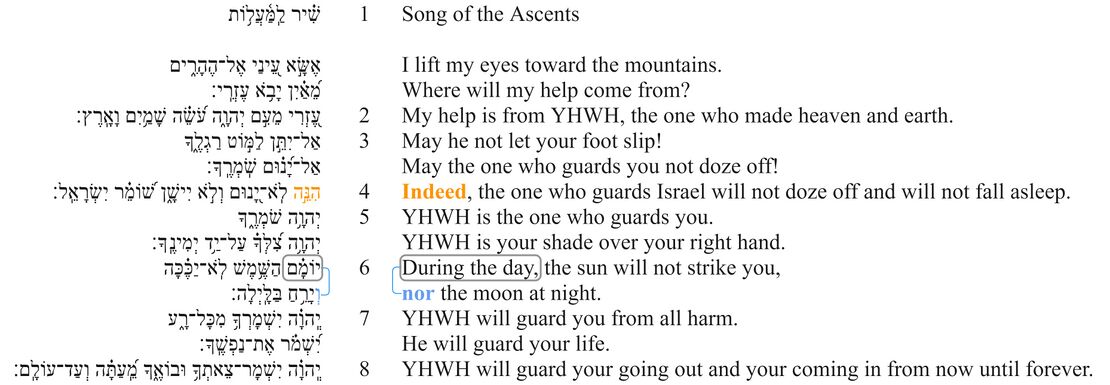Psalm 121 Macrosyntax
From Psalms: Layer by Layer
Psalm 121/Macrosyntax
Choose a PsalmNavigate Psalm 121
Macrosyntax
Macrosyntax Diagram
| Macrosyntax legend | |
|---|---|
| Vocatives | Vocatives are indicated by purple text. |
| Discourse marker | Discourse markers (such as כִּי, הִנֵּה, לָכֵן) are indicated by orange text. |
| The scope governed by the discourse marker is indicated by a dashed orange bracket connecting the discourse marker to its scope. | |
| The preceding discourse grounding the discourse marker is indicated by a solid orange bracket encompassing the relevant clauses. | |
| Subordinating conjunction | The subordinating conjunction is indicated by teal text. |
| Subordination is indicated by a solid teal bracket connecting the subordinating conjunction with the clause to which it is subordinate. | |
| Coordinating conjunction | The coordinating conjunction is indicated by blue text. |
| Coordination is indicated by a solid blue line connecting the coordinating clauses. | |
| Coordination without an explicit conjunction is indicated by a dashed blue line connecting the coordinated clauses. | |
| Marked topic is indicated by a black dashed rounded rectangle around the marked words. | |
| The scope of the activated topic is indicated by a black dashed bracket encompassing the relevant clauses. | |
| Marked focus or thetic sentence | Marked focus (if one constituent) or thetic sentences[1] are indicated by bold text. |
| Frame setters[2] are indicated by a solid gray rounded rectangle around the marked words. | |
| [blank line] | Discourse discontinuity is indicated by a blank line. |
| [indentation] | Syntactic subordination is indicated by indentation. |
| Direct speech is indicated by a solid black rectangle surrounding all relevant clauses. | |
| (text to elucidate the meaning of the macrosyntactic structures) | Within the CBC, any text elucidating the meaning of macrosyntax is indicated in gray text inside parentheses. |
If an emendation or revocalization is preferred, that emendation or revocalization will be marked in the Hebrew text of all the visuals.
| Emendations/Revocalizations legend | |
|---|---|
| *Emended text* | Emended text, text in which the consonants differ from the consonants of the Masoretic text, is indicated by blue asterisks on either side of the emendation. |
| *Revocalized text* | Revocalized text, text in which only the vowels differ from the vowels of the Masoretic text, is indicated by purple asterisks on either side of the revocalization. |
(Click diagram to enlarge)
- The macrosyntactic features observed at this layer do not suggest any particular division of the text into smaller units.
- v. 6.
- The non-default word order in v. 6 creates a chiasm:[3] A. "during the day"; B. "the sun"; C. "will not strike you"; B'. "the moon"; A'. "at night". Lunn argues that the word order in this verse might be marking a literary peak in the psalm.[4] Indeed, v. 6 further stands out as being the only verse in vv. 3–8 that does not have the word שׁמר. This word occurs three times before v. 6 and three times after it.
- In addition to creating a chiastic pattern, the fronted adverbial "during the day" could function as a frame-setter.
- vv. 7–8. The subject-predicate word order in vv. 7a, 8a matches the subject-predicate word order in v. 5. Note especially the similarity between יְהוָה שֹׁמְרֶךָ in v. 5a (the beginning of a poetic section) and יְהוָה יִשְׁמָרְךָ in v. 7a (the beginning of the next poetic section). Thus, the non-default subject-verb word order in vv. 7–8 is part of a poetic pattern. It might also be that the subject-verb word order in vv. 7–8 is necessary to mark these clauses as indicative (or assertive). Verb-subject word order might have implied directive (or projective) semantics : "May YHWH guard...".[5]
- v. 5. The verbless clauses in v. 5a and v. 5b each predicate something about YHWH: "YHWH (topic) is your guard, i.e., the one who guards you. YHWH is your shade..." Alternatively, it is plausible that the verbless clause in v. 5a is specificational (rather than predicational): "(Who is the one who guards you [see v. 3a]?) YHWH is the one who guards you" (cf. vv. 1–2).
- v. 4. The discourse marker indeed (הִנֵּה) at the beginning of v. 4 signals to the reader that the information in v. 4 is "noteworthy or newsworthy with respect to the other discourse active information."[6] Specifically, it signals that the content of v. 4 "modifies the content or implicatures of statements in the preceding cotext," providing either confirmation, elaboration, or a clarification.[7] The previous verse expressed a wish, or a blessing ("May he..."), with the implicit possibility that it might not come true. But v. 4 corrects this possible misunderstanding and affirms, without doubt, that YHWH will not doze off or fall asleep.
- ↑ When the entire utterance is new/unexpected, it is a thetic sentence (often called "sentence focus"). See our Creator Guidelines for more information on topic and focus.
- ↑ Frame setters are any orientational constituent – typically, but not limited to, spatio-temporal adverbials – function to "limit the applicability of the main predication to a certain restricted domain" and "indicate the general type of information that can be given" in the clause nucleus (Krifka & Musan 2012: 31-32). In previous scholarship, they have been referred to as contextualizing constituents (see, e.g., Buth (1994), “Contextualizing Constituents as Topic, Non-Sequential Background and Dramatic Pause: Hebrew and Aramaic evidence,” in E. Engberg-Pedersen, L. Falster Jakobsen and L. Schack Rasmussen (eds.) Function and expression in Functional Grammar. Berlin: Mouton de Gruyter, 215-231; Buth (2023), “Functional Grammar and the Pragmatics of Information Structure for Biblical Languages,” in W. A. Ross & E. Robar (eds.) Linguistic Theory and the Biblical Text. Cambridge: Open Book Publishers, 67-116), but this has been conflated with the function of topic. In brief: sentence topics, belonging to the clause nucleus, are the entity or event about which the clause provides a new predication; frame setters do not belong in the clause nucleus and rather provide a contextual orientation by which to understand the following clause.
- ↑ Cf. Maré 2006, 714.
- ↑ Lunn 2006, 181.
- ↑ See Gentry 1998, 22–24.
- ↑ Miller-Naudé and van der Merwe 2011, 79.
- ↑ Miller-Naudé and van der Merwe 2011, §3.3.2.


